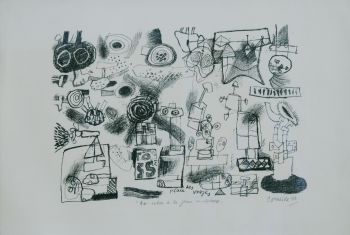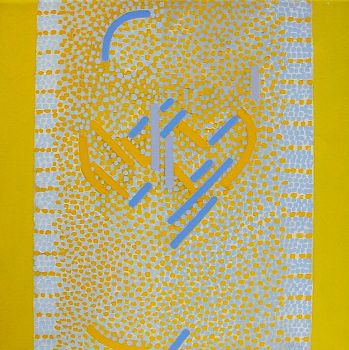About the artist
Ellen Jess studied at three different academies in three countries: Karlsruhe in Germany, Washington in the US and den Bosch here in the Netherlands, countries where she also lived. She is an idiosyncratic artist, who gets to the bottom of both a theme and a technique with great success.
Her theme in recent years is the iris flower. The material consists of layers of painted Japanese paper. Ellen is a very erudite woman who knows her way around, a hard worker. She has a huge studio, a factory hall, which is completely filled with her works of art, some ready and many in progress, dizzying.
As for the technique: layers of painted Japanese paper. I have twice before had an artist in the gallery who worked with Japanese paper. The first time was Nikki van Es in my first 'POP-UP Gallery' in Wageningen University in 2012 with paper hanging freely in space, painted with non-existent plant motifs from DNA to cut through trees. In 2013 the Swiss Annette Haeberling with torn painted patches of paper glued together, works inspired by nature. And now Ellen Jess. But this is very different. I've seen Ellen busy and she almost models with the paper, makes 3-dimensional shapes like in these perspex cabinets. Or many layers close together. The coloured paper is folded and arranged into a whole in a style entirely of its own.
What about the theme? I recently gave two lectures in Museum Arnhem on 'valuing art' and 'collecting art'. And one of the theses was 'art gives insight'. Insight into history, life around us, our society, ourselves. That's why people put art in their homes: to gain insight by letting the insight that an artist had, and wants to convey, influence you.
What insight does the art of Ellen Jess give us? To find out, I compared her art with that of her husband, Theo Kuijpers, who had a wonderful exhibition at Museum de Pont in Tilburg last year. With his earth tones he puts us with both feet on the ground, in Australian nature or with pastel tones in a Mediterranean city: he roots us in our surroundings. Not Ellen. Her work is much more ethereal, lighter. Where does she take us? That is the flower of the iris plant. The use of a lot of blue makes the work light and airy. The deeper meaning, at least for me as a biologist, is reproduction, reproduction, in all kinds of forms, including human. Not that she represents that process or that act, but the atmosphere, the importance. Look at the work: 'Iris heart'. And it dances, look at the work: 'the light draws the Iris'. You could also call this exhibition: Dance of procreation.
It also fits very nicely with the sculptures of Jan Pater, some of which are from the previous exhibition, all twisting. Following the press release about Jan's exhibition, I was invited for an interview with radio Arnhem. The first question was: 'the artist is inspired by the human torso. So it's definitely about breasts and buttocks'? That's not so. In the art of Jan Pater the torso is more than a 'Sexual Persona' (Camille Paglia); it's about that whole person, including feeling and psyche. It's the same with Ellen's work in which she depicts the reproduction of organisms for me. She does not depict that act, or those organs, but the essence. Her art is about the dance of life.
























